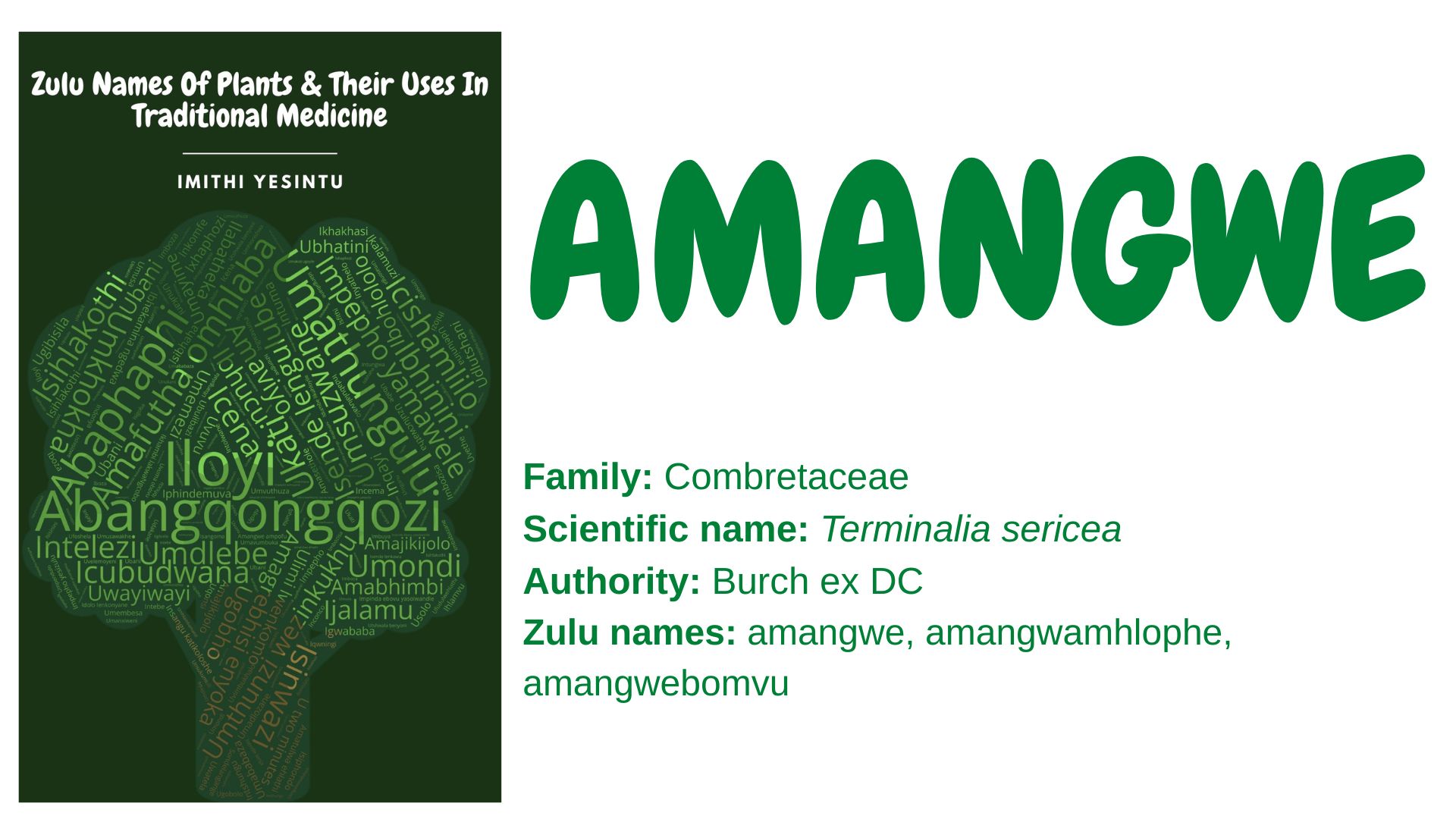Family: Combretaceae
Scientific name: Terminalia sericea
Authority: Burch. ex DC.
Synonym: Myrobalanus sericea (Burch. ex DC.) Kuntze
Zulu names: amangwe, amangwamhlophe, amangwebomvu
Other names: silver cluster leaf (English), vaalboom (Afrikaans)
Plant description: T. sericea is a small-to-medium sized deciduous tree. It has dark green leaves that are clustered at the end of the branch and have hair underneath. The flowers are small, white, with a strong and unpleasant scent. The fruits are held in clusters as nuts surrounded by a hard ribbed wind with a pale green colour when young and brown or pinkish brown when ripe. The tree is native to Southern Africa and occurs in woodland and bushveld habitats, typically growing in sandy soils.
Uses:
- The plant is mixed with other plants and the mixture used to enhance virility in men.
- The roots are used to treat diarrhoea. The roots are dried and ground to powder then boiled, maize meal is added to the decoction to make soft porridge that is eaten to treat diarrhoea.
- The leaves are used to treat menorrhagia.
- The leaves are dried and powdered are used to make a paste that is applied topically on wounds.
- The roots are used to treat bilharzia, tuberculosis, and pneumonia.
- The roots are used to strengthen the fontanelle of newborn babies. The roots are mixed with those of Cassia abbreviata and the bark of Peltophorum africanum to make a decoction that is administered to babies.
- The roots are used to make a tonic for general immunity.
- The roots are mixed with those of T. phanerophlebia to make an emetic that is used to cause and protect against an illness.
- The bark is used for wound dressing and to treat inflammation and skin rashes.
- The bark is used to treat diabetes mellitus.
- The leaves and roots are used to treat stomach disorders.
- The bark is used as an emetic and a wash to protect yourself from witchcraft.
- The bark is used as a poison antidote.
- The bark is used in the making of ropes.
- The roots are used as a dye.
- The wood is used in construction. It is used to make furniture, household utensils, tool handles, and poles.
- The wood is also used as fuelwood.
- The tree is cultivated as an ornamental.
Safety precaution:
Using traditional medicine responsibly can enhance your overall health and well-being. Misuse and abuse can lead to complications. You can inquire about the correct use of traditional medicine from a knowledgeable herbalist and practitioner. You can also visit imithiyesintu.co.za or email: info@imithiyesintu.co.za to learn more about traditional medicine
References and further reading:
- Arnold, H.J. and Gulumian, M., 1984. Pharmacopoeia of traditional medicine in Venda. Journal of Ethnopharmacology, 12(1), pp.35-74.
- Gerstner, J., 1941. A preliminary checklist of Zulu names of plants with short notes. Bantu Studies 15, pp. 369–383.
- Hutchings, A., 1996. Zulu medicinal plants: an inventory. University of Natal Press, Pietermaritzburg.
- Kokwaro, J.O., 1976. Medicinal plants of east Africa.
- Loffler, L. and Loffler, P., 2005. Swaziland Tree Atlas.
- Makhado, R.A., Von Maltitz, G.P., Potgieter, M.J. and Wessels, D.C., 2009. Contribution of woodland products to rural livelihoods in the northeast of Limpopo Province, South Africa. South African Geographical Journal, 91(1), pp.46-53.
- McGaw, L.J., Lall, N., Meyer, J.J.M., and Eloff, J.N., 2008. The potential of South African plants against Mycobacterium infections. J. Ethnopharmacol. 119, pp. 482–500.
- Mongalo, N.I., McGaw, L.J., Segapelo, T.V., Finnie, J.F. and Van Staden, J., 2016. Ethnobotany, phytochemistry, toxicology and pharmacological properties of Terminalia sericea Burch. ex DC.(Combretaceae)–A review. Journal of ethnopharmacology, 194, pp.789-802.
- Pujol. J., 1990. Naturafrica—the herbalists handbook. Jean Pujol Natural healers foundation, Durban.
- Van Wyk, B.E., van Oudtshoorn, B. and Gericke, N., 2009. Medicinal plants of South Africa, 2nd edn. Briza Publications, Pretoria.
- Watt, J.M. and Breyer-Brandwijk, M.G., 1962. Medicinal and poisonous plants of southern and eastern Africa, second edition. Livingstone, London.
- York, T., de Wet, H., and Van Vuuren, S.F., 2011. Plants used for treating respiratory infections in rural Maputaland, KwaZulu-Natal, South Africa. J. Ethnopharmacol. 135, pp. 696–710.
You Can Order Your Copy Of The Book By Emailing: info@imithiyesintu.co.za
Feel Free To Add Other Uses Of This Plant In The Comment Section Below:

